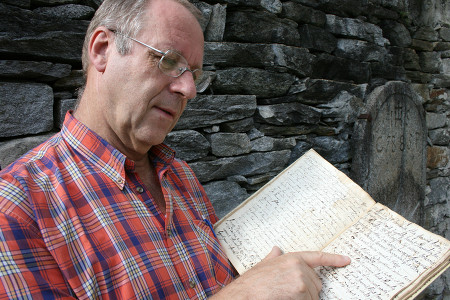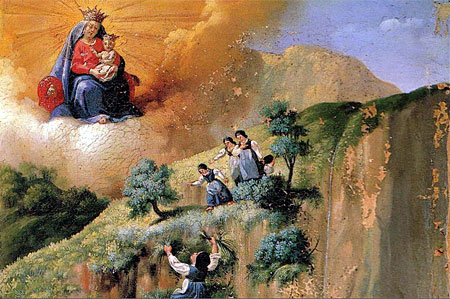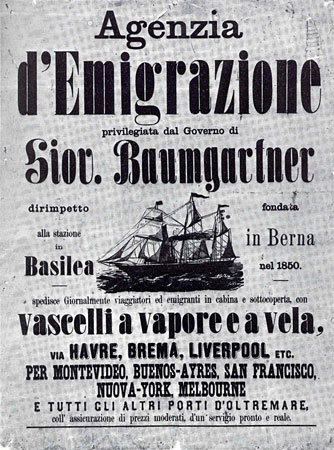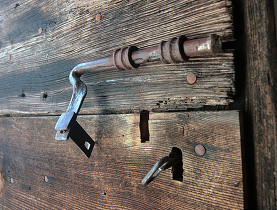Furnishing Ticino’s genealogical castle

Ronald Willemse leafs through the fragile pages of a 300-year-old marriage register from the small community of Frasco in the Verzasca Valley.
A substantial piece of the first page is missing; some of it eaten by mice and part damaged by humidity.
Yet Willemse says even the entries on the intact pages are often incomplete or misleading. The expatriate Dutchman is a data recovery expert so he knows what he is talking about.
In his free time – instead of reconstructing crashed computer drives – he pieces together genealogical information on all of the patrician families of Frasco and neighbouring Sonogno.
“One case involved twins and the priest forgot to register the second child and wrote in the details a few months later,” Willemse explains. “In another case there was a mix up between the godparents and the real parents, so it takes time before you can complete the puzzle.”
Willemse put his genealogical database for the two communities online four years ago. It currently has 3,000 family sheets listing 11,000 different people.
The tall, gregarious man moved to Ticino in the early 1960s from the Netherlands and eventually married a woman whose family originates from Sonogno.
After putting together a database on his Dutch ancestry, it was only a question of time before the amateur genealogist would turn his attention to his wife’s roots.
Genealogical challenge
He soon discovered that unlike his native land, Ticino had made little progress transcribing or digitalising old records. Willemse saw this as a challenge and decided to investigate the records of all of the Frasco and Sonogno families.
“I thought, if there is nothing available here yet, I won’t limit my work to the direct ancestors of my wife, but take all of them – since the villages are so small – and leave good transcriptions for others who may eventually want to conduct research.”
Willemse says one can learn a lot and nothing from genealogy.
“If you only have names, and date of birth/death and children’s names, it doesn’t teach you anything,” he explains. “It’s like building a castle with empty rooms. The interesting part is to fill up the rooms with furniture.”
Ancestral furniture
The furniture, he says, can include a person’s profession, correspondence, or legal documents such as land deeds. “Only with this additional information can you begin to understand a little bit about the person.”
His comprehensive research has also shed light on 19th century conditions in what were alpine villages mired in poverty.
He found for example that in 1854 one ship departed Hamburg for the gold mines of Australia with more than 50 Ticino immigrants on board. The vast majority failed to find their fortune and returned a year or two later only to borrow money to try their luck again overseas, this time in California.
“The registers show who received a loan to finance the journey and who was in Australia at the time,” he says.
Infant mortality
The records also reveal that infant mortality was quite high, a key indicator of how poor the communities were.
Birth, marriage and death records are the main sources for Willemse’s work, as well as another book called the “Status Animarum”. The census-like registry was compiled by the local priest to show the visiting bishop.
The records for both Frasco and Sonogno were kept in the same books until 1735 since they belonged to the same parish, but were then registered separately when the parish was split into two.
However, the genealogist also has to consult the records of Gordola near Lake Maggiore at the valley entrance since many of the villagers came here with their livestock as part of the seasonal migrations, or transhumance.
“People may have married in Frasco, Sonogno or – in winter – in Gordola. Children born in winter when the parents were in Gordola were also baptised there, that’s why all the registers have to be put together to make reliable family sheets.”
Willemse says he derives a lot of satisfaction helping people learn about their ancestry.
“I think other communities in Ticino should follow our lead and try to link data.
“I started a job that I want to finish, which I know is impossible since you are never finished.”
Dale Bechtel in Sonogno and Frasco, swissinfo.ch
Sonogno is the last village in the Verzasca valley, located at an altitude of 909 metres above sea level. It has about 85 inhabitants.
The patrician family names of Sonogno are: Cattori, Fratessa, Garatti, Genardini, Gianettoni, Macciantelli, Martella, Matasci, Pagnamenta, Patà, Pelucca, Perozzi, Pinana, Sonanini, Sonognini, Tamò.
In neighbouring Frasco they are: Badasci, Bernardasci, Danini, Delubini, Dughi, Ferrasci, Ferrini, Franchini, Giottonini, Jop, Joppi, Joppini, Lanini, Lesnini, Marci.

In compliance with the JTI standards
More: SWI swissinfo.ch certified by the Journalism Trust Initiative





You can find an overview of ongoing debates with our journalists here. Please join us!
If you want to start a conversation about a topic raised in this article or want to report factual errors, email us at english@swissinfo.ch.